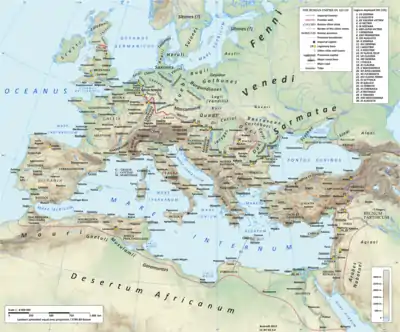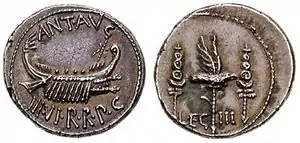Legio III Cyrenaica
Legio III Cyrenaica (Legio Tertia Cyrenaica, "Cyrenean Third Legion") was a legion of the Imperial Roman army. The origins of the legion remain unknown. One source believes the legion was probably founded by Mark Antony around 36 BC, when he was governor of Cyrenaica. Equally, the legion's origins may come from the fact it was commanded by Lucius Pinaris Scarpus, an ally of Mark Antony whom Antony appointed to be governor of Cyrenaica in eastern Libya.[1] There are still records of the legion in Syria in the beginning of the 5th century. The legion symbol is unknown. Legion III Cyrenaica was one of the longest-living Roman legions.


History
Origins and Service in Egypt
The Origins of the Legion are unclear, however it was probably founded by either Marcus Antonius or Lepidus.[2] This is because both Triumvirs controlled Cyrenica.[2] Although, some theories suggest that the Legion already existed and received the name Cyrenica after it was stationed there.[2] Augustus used the legion to occupy Thebes in Egypt after he had annexed it in 30 AD.[2] Interestingly, the soldiers of this legion took towards worshiping an Egyptian god named Ammon.[2] In either in 7 AD or 9 AD it was transferred to Alexandria.[2] In 26-25 BC a vexillatio of III Cyrenaica took part in a Roman attack on Arabia Felix.[2] The campaign was commanded Aelius Gallus, the prefect of Egypt.[2] This caused the province of Egypt to be unprotected, as the legions were off fighting.[2] Because of this the Nubian kingdom of Meroe attacked Upper Egypt.[2] In 24 AD a Roman governor named Gaius Petronius took the legions, one of which was III Cyrenaica, and marched upstream along the Nile and reached Napata, the capital of Nubia.[2] After this, the Nubians attacked the Romans a lot less.[2] The III Cyrenaica would have to suppress violence among the ethnic groups living in the city: Greeks, Egyptians, and Jews.
Service Throughout the Rest of the Empire
On other occasions, vexillatios were sent abroad.[2] It is possible that one of them was sent to Tongeren in Gallia Belgica during the reign of Caligula, which may have been part of the army he wanted to use to invade Britain.[2] Another vexillatio took part Domitius Corbulo's campaign against the Parthian Empire in 63 AD.[2] During the First Romano-Jewish war, the Third and Twenty-Second legions fought against the Jews of Alexandria.[2]
Year of Four Emperors
When the Year of Four Emperors had broken out between several Roman generals, the III Cyrenaica were among the first supporters of the new emperor Vespasian.[2] This could be because a subunit of the III Cyrenaica took part in the Siege of Jerusalem in 70 AD. In 106 AD the legion was transferred to the province of Arabia Petraea.[2] Its base was at Bosra.[2]
Service During the Reigns of the Five Good Emperors
After the legion had returned to Egypt, It is probable that this relocation had something to do with the emperor Trajan's war against the Parthians, and/or the rebellion of the Jews of Alexandria.[2] However, the legion returned to Arabia after 125 AD.[2] Between 132 AD and 136 AD, subunits of this legion fought against the Jews when they revolted under Simon bar Kokhba. Soldiers of III Cyrenaica could be sent to other parts of the Roman empire.[2] During the reign of Antoninus Pius, they were stationed in Hegra, and subunits fought in Mauretania against the Moors.[2] Later, subunits of the III Cyrenica took part in a campaign against the Parthians lead by Lucius Verus from 162-166 AD.[2] In 175 AD, the legion sided with Avidius Cassius, a Roman general who revolted against Marcus Aurelius, but was killed by his own officers.[2]
Later History
During the civil war following the death of the emperor Commodus on the last day of the year 192 AD the III Cyrenaica sided with the eastern pretender Pescennius Niger.[2] Niger would be defeated by Lucius Septimius Severus.[2] Severus would invade Mesopotamia to fight against the Parthians.[2] It is possible that the Third legion took part in these campaigns.[2] It was certainly present when Severus' son Caracalla launched another Parthian campaign.[2] The legion also could have taken part in Severus Alexander's war against the Sasanids.[2]In 260 AD, the Sasanids took the Roman emperor Valerian captive, and several Roman provinces in the east became independent under Odaenathus of Palmyra.[2] Odenauthus led Roman units against the Persians, one of which was the III Cyrenica. In 273 AD the legion helped build roads in Jordan.[2] The later history of this unit is unclear, but the third Cyrenaican legion was still at Bosra at the beginning of the fifth century.[2]
Timeline
The following is a list of campaigns and actions thought to have been seen by Legion III Cyrenaica during much of its existence:
- 35(?) BC - Leg. III is formed, likely by Mark Antony or Lepidus in Cyrene. At this time, Legions still likely hold to the Republic tradition of being numbered in order of their creation, so this may have been the third Legion that [Anthony] had established and had under his direct command and loyalty.
- 31 BC – (Battle of Actium) – Either before or after Anthony and Cleopatra are defeated by Octavian (later Augustus), it is thought soldiers of Leg. III Cyrenaica defect from Anthony and claim allegiance to Octavian - who spares the Legion from being disbanded.
- 26 – 25 BC – Action in Arabia Felix (Yemen), commanded by Aelius Gallus, Prefect of Egypt.
- 23 BC – Action against Nubian invaders, Elements of III likely stationed in Thebes, Egypt.
- 23(?) BC (AD?) - Roman military presence in Egypt is reduced to 2 Legions: III Cyrenaica and XXII Deiotariana. Which other Legions, or how many there were, is not known.
- AD 7 – 11 – Suggested time period that the double-fortress at Nikopolis is established.
- AD 11 – Elements of Leg III under command of Publius Juventius Rufus, stationed in Berenike.
- AD 39 / 40 – A detachment (vexillation) of Leg III was sent up to the northern coast of Gaul (France) to assist Emperor Caligula's legions with his rather unimpressive invasion of Britain. III was apparently used as a logistics and supplies organizer for the invasion / landing force.
- AD 58 – 63 – Under the command of Gn. Domitius Corbulo, elements of III saw action in the Parthian frontier.
- AD 66 – 70 – The First Jewish–Roman War. An uprising of Jews starts in Alexandria, and spreads to Judea. Elements of III and XXII fought their way to Jerusalem, and with the assistance of several other legion, auxiliary and allied forces (around 60,000 troops) surrounded and besieged the city, led by Vespasian, Proconsul of Africa.
- AD 69 – "Year of the Four Emperors". Factions led by Galba, Otho, and then Vitellius all tried to seize control of Rome after the death of Nero. These factions, who had no aristocratic claim to the throne, (and hardly any support of the legions nor the Senate) all tried to take control one after another by force.
- July 1 – With support of Gaius Licinius Mucianus, Governor of Syria and Tiberius Alexander, Prefect of Egypt, Vespasian is urged to revolt and take the throne. The legions in Alexandria, two days later those of Judea, and then in August those of Syria and the Danube region declare Vespasian Emperor. Vespasian sends Mucianus to march on Rome with 20,000 troops while Vespasian heads to Alexandria to control the grain supply and starve Rome into submission.
- December 22 Vespasian is sworn in as emperor while still in Egypt.
- AD 70 – A vexillation of Leg III, along with X Fretensis, completes the siege of Jerusalem under the command of Vespasian's son, Titus.
- AD 84 – 88 – It is believed a detachment of Leg III is sent to help repair a footbridge along the Danube River, with legions VII Claudia, IV Flavia Felix, and either I or II Adiutrix. A stone engraving commemorating the bridge mentions "The Legion from Egypt". III appears to have been sent out abroad more often than XXII, so it is possible this is referring to III.
- AD 90 – Soldiers of III construct a bridge in Koptos (likely to improve or support roads to ports in Berenike and Quseir).
- AD 107 – 109 – Previously suggested date when Leg III departs Egypt - May instead be elements of III on expeditionary missions into Syria.
- AD 116 – Elements of III (or XXII?) are sent back to Judea to suppress another revolt, known as the Kitos War
- AD 120 or 127 – III makes its departure from Egypt, being relocated to Bosra (aka Bostra, Syria / Jordan), where the capital was renamed from Petra to Nova Trajana Basra honoring Emperor Trajan. While in Bosra, Leg III constructs city gates, bridges and a massive amphitheater, which still exists today and is a popular tourist attraction. Meanwhile Legion II Trajana Fortis replaces III in Egypt.
- AD 132 – 136 – Yet another Jewish war, the Bar Kokhba revolt. It is thought elements of III and XXII are sent to Judea. Legion XXII may have been destroyed during this war, or perhaps the earlier Kitos War.
- AD 162 – 166 – Elements of III again in Parthia, under command of Lucius Verus.
- AD 193 – Leg III supported Pescennius Niger in his failed attempt to take the throne after Emperor Commodus.
- AD 262 – 267 – It is possible that elements of III were involved with fighting Queen Zenobia in Palmyra (Syria).
- AD 420s or 430s – III is listed in the Notitia Dignitatum, a record of Roman military units and their stations. Legion III is listed as Praefectus legionis tertiae Cyrenaicae, Bostra.
- AD 630 (?) III Cyrenaica is likely destroyed fighting the Muslim conquest of the Levant.
(Information researched and compiled by group members of Leg. III Cyrenaica, a Roman Legion Reenacting/Living History group, see link below)
See also
External links and references
- Pollard N. & Berry J., 'The Complete Roman Legions', p 156
- "Legio III Cyrenaica - Livius". www.livius.org. Retrieved 2020-08-02.
- Richard Alston - "Soldier and Society in Roman Egypt: A social history", Routledge Press 1995.
- Emil Ritterling - "Legio" article published in Realencyclopädie of Klassischen Altertumswissenschaft in 1925
- H. A. Sanders - JSTOR article written 1941)
- John Paul Adams - (California State University, Northridge)
- Adrian Goldsworthy - "The Complete Roman Army", Thames & Hudson 2003.
- Jona Lendering - Livius.org
- Peter Connolly - "Greece and Rome at War", Greenhill Books 1981, 1998.
- Phil Barker - "The Armies and Enemies of Imperial Rome", Wargames Research Group Publications 1981.
- Bishop & Coulston - "Roman Military Equipment", Oxbow Books 1993.
- De Imperatoribus Romanis (On the Roman Emperors)
Osprey books:
- Simkins / Embelton - The Roman Army from Caesar to Trajan (Men at Arms #46)
- Cowan / McBride - Roman Legionary: 58 BC - AD 69 (Warrior #71)
- Sumner - Roman Military Clothing 1,2,3 (Men at Arms #374, 390, 425)
- Campbell / Hook - Siege Warfare in the Roman World (Elite #126)
- Cowan / Hook - Roman Battle Tactics: 109 BC - AD 313 (Elite #155)
- Gilliver / Goldsworthy / Whitby - Rome At War: Caesar and his Legacy (Essential Histories)
Bibliography
| Wikimedia Commons has media related to Legio III Cyrenaica. |
- Emil Ritterling, Legio, Realencyclopädie of Klassischen Altertumswissenschaft, 1925, Columns 1506–1514
- H. A. Sanders, "The Origin of the Third Cyrenaic Legion", American Journal of Philology, 62 (1941), pp. 84–87.
- Johannes Kramer, "Die Wiener Liste von Soldaten der III. und XXII. Legion (P. Vindob. L 2)", Zeitschrift für Papyrologie und Epigraphik, 97 (1993), pp. 147–158
- G. W. Bowersock, "A Report on Arabia Provincia", The Journal of Roman Studies, 61 (1971), pp. 219–242
- Karl Strobel, "Zu Fragen der frühen Geschichte der römischen Provinz Arabia und zu einigen Problemen der Legionsdislokation im Osten des Imperium Romanum zu Beginn des 2. Jh.N.Chr", Zeitschrift für Papyrologie und Epigraphik, 71 (1988), pp. 251–280
- John Peter Oleson, M. Barbara Reeves, Barbara J. Fisher, "New Dedicatory Inscriptions from Humayma (Ancient Hawara), Jordan", Zeitschrift für Papyrologie und Epigraphik, 140 (2002), pp. 103–121
- P.-L. Gatier, "La Legio III Cyrenaica et l'Arabie", in dans Les légions de Rome sous le Haut-Empire, I, Lyon, 2000, p. 341–344
- A. Kindler, The Coinage of Bostra (Warminster 1983) 87–95.
- D. Kennedy originally, "Legio VI Ferrata: The Annexation and Early Garrison of Arabia", Harvard Studies in Classical Philology, 84 (1980) 282–309

